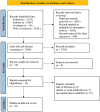Prevalence of scoliosis in children and adolescents: a systematic review and meta-analysis
- PMID: 39108696
- PMCID: PMC11300313
- DOI: 10.3389/fped.2024.1399049
Prevalence of scoliosis in children and adolescents: a systematic review and meta-analysis
Abstract
Background: The understanding of the prevalence and early predictive factors of scoliosis in children and adolescents is limited, which poses challenges to developing preventative strategies. This systematic review and meta-analysis aimed to clarify the prevalence and predictors of scoliosis among children and adolescents.
Methods: We conducted a comprehensive search in PubMed, Cochrane, Embase, and Web of Science through October 2023. The quality of included studies was evaluated using the Joanna Briggs Institute scale or the Newcastle-Ottawa Scale. Subgroup analyses were performed to examine different types of scoliosis and specific demographic groups.
Results: From 32 studies encompassing 55,635,351 children and adolescents, we identified 284,114 cases of scoliosis, resulting in a prevalence rate of 3.1% (95% CI: 1.5%-5.2%). This rate varied by gender, degrees of scoliosis severity, and between idiopathic vs. congenital forms. Notable predictors included gender, age, Body Mass Index (BMI), race, environmental factors, and lifestyle choices.
Conclusion: Scoliosis is a significant condition affecting a minority of children and adolescents, particularly adolescent girls and individuals who are overweight. It is recommended that guardians and schools enhance educational efforts towards its prevention.
Systematic review registration: https://www.crd.york.ac.uk/, Identifier CRD42023476498.
Keywords: adolescents; children; prevalence; risk factors; scoliosis; systematic review.
© 2024 Li, Nie, Liu and Jiang.
Conflict of interest statement
The authors declare that the research was conducted in the absence of any commercial or financial relationships that could be construed as a potential conflict of interest.
Figures







References
-
- White AA, 3rd, Panjabi MM. The clinical biomechanics of scoliosis. Clin Orthop Relat Res. (1976) (118):100–12 - PubMed
Publication types
LinkOut - more resources
Full Text Sources

